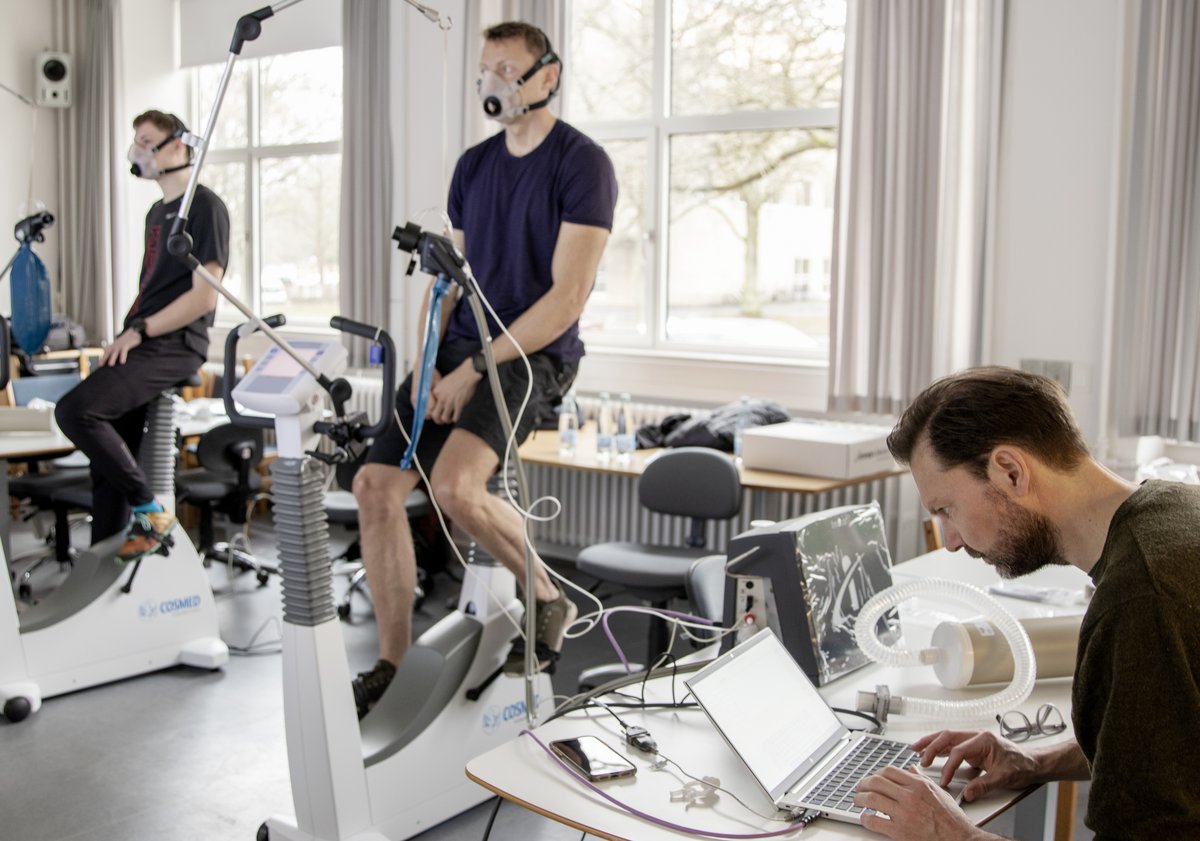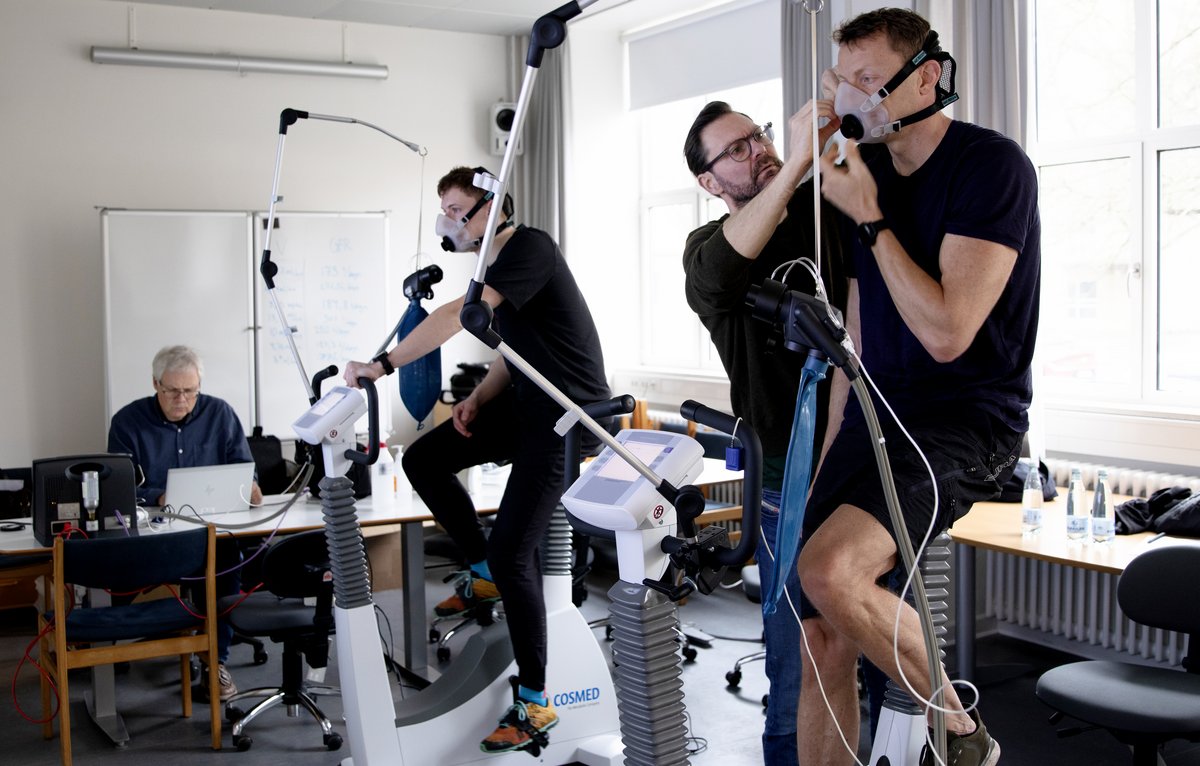Watch the video: Time for the medical students to sweat
The medical degree programme in Aarhus has received a boost with the delivery of some long-awaited equipment, which provides a practical understanding of what happens in the body under workload.
Facts
Innocor® can measure oxygen uptake, cardiac output (how much blood the heart pumps per minute), stroke volume (how much blood the heart pumps per heartbeat), pulse, ventilation and oxygen uptake.
During a rebreathing test the subject re-breathes an oxygen enriched mixture delivered by the integrated gas cylinder into a closed rebreathing system.
The mixture contains very small amounts of two physiologically inert gases – one is blood soluble (N2O) and the other an insoluble (SF6) tracer gas.
Innocor® CO measures the concentration curve of the blood soluble gas and calculates the washout rate, which is proportional to the cardiac output.
The blood insoluble gas is measured to determine the lung volume and to account for other factors that affect the distribution of the blood soluble gas.
The system uses Inert Gas Rebreathing, which is based on the German researcher Adolf Fick's principle that the flow of blood through an organ is equal to its intake or release of a substance (e.g. oxygen) divided by the difference in concentration between arterial and venous blood for the substance.
In contrast to other non-invasive techniques, Innocor can be used in the same way for patients at rest and during exercise.
In a room at the Department of Biomedicine, two ergometer bikes are set-up in front of a wall with large flat screen TVs. Each bike is equipped with a blue sack, which among other things, contains oxygen and 0.5 per cent nitrous oxide.
A student and a course manager have volunteered as test subjects for the new equipment, and they are very focused on turning the pedals. The large TV screens show that both test subjects have reached a heart rate between 160 and 180 beats per minute. Both are breathing heavily, their arteries straining in the temples, and their faces are becoming increasingly red behind the tight-fitting masks.
"The students shouldn’t only read about heart volume and pulse rates in a book. It’s important for coming medical doctors to have a good understanding of the basic mechanisms that begin when the body regulates itself while under workload," says Associate Professor Frank de Paoli. He is the person behind the procurement of the equipment, which has cost just over a million Danish kroner.
The system is called Innocor and can, among other things, measure oxygen uptake, cardiac output, depth of breathing and many of the other parameters that change when the body goes from rest to work. The transportable equipment is easy to move and set up for the students to use.
“It’s been on our wish list for five years, so we're extremely pleased that we've got it now and can begin using it this semester," says Frank de Paoli.
Students on the second year of the medical degree programme will benefit from the equipment when learning about e.g. biochemistry and physiology.
Inhale nitrous oxide and sulphur hexafluoride
"Innocor is a good way to measure cardiac output without taking blood samples," says Knud Pedersen. He is a product specialist at the supplier Cosmed Nordic and is there to adjust and monitor equipment such as tubes, masks and computer programs.
The mixture that the test subjects inhale through the tightly fitted masks around their mouth and nose contains small amounts of two gases – nitrous oxide (N2O), which is soluble in blood, and the insoluble trace gas sulphuric hexafluoride (SF6).
A sensor measures how much of the blood-soluble nitrous oxide the test person exhales, and the system calculates the washout rate, which is proportional to the cardiac output. The screen shows how much blood the heart is able to pump in the course of a minute. Having the ability to measure cardiac output also means having a tool to determine whether it is the ventilation or the heart itself that is the problem in a patient.
One of the test persons dismounts from the bike. He is Christian Vægter, associate professor and course manager at the Department of Biomedicine.
"You could say that we work hard for the students," he says with a smile and hair that is damp after his efforts.
He and Frank de Paoli agree that the new equipment will give the medical degree programme a boost.
"The students have to learn a lot of theory in this area. Now they can learn in practice in a completely new way, which is going to give them a more complete understanding of the knowledge you need to have as a medical doctor," says Christian Vægter.
Frank de Paoli nods in agreement:
"The Danish population is getting older and older, and it’s extremely important that the students understand how training affects the body, both in relation to exercise and prevention and as medicine."


